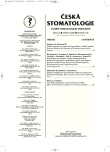Healing of Pathologic Bone Cavities of Jaws after Augmentation
Authors:
M. Machálka; O. Bulik; O. Liberda
Authors‘ workplace:
Klinika ústní, čelistní a obličejové chirurgie LF MU a FN, Brno
Published in:
Česká stomatologie / Praktické zubní lékařství, ročník 109, 2009, 3, s. 54-57
Overview
Pathologic bone cavities of jaws are related to occurrence of bone cysts and tumors. In an extensive bone cavity after cystectomy, the post-operative haematoma may disintegrate due to inflammation at the dehiscence of the mucosa suture. The cavity originated by the cyst is connected with the oral cavity; the healing is complicated and long-continuing. We endeavor to fill this cavity with some kind of material that would not only reduce the cavity extent but also stimulate the bone re-creation.
Within the framework of our research activity, we applied three shares of human lyophilized bone mash and one share of tricalcium-phosphate, which were mixed with venous blood of the respective patient until consistent material for augmentation was made. No antibiotics were added. Stage of bone healing and possible complications were regularly followed both in patients after augmentation and in a control group of patients without implanted material.
Hitherto results revealed non-complicated healing in 32 patients in whom the augmentation with mixture of the above materials had been carried out (21 bone cavities after cysts and 11 benign bone tumors).
Key words:
odontogenic bone cysts - augmentation - lyophilized bone mash
Sources
1. Fassmann, A.: Řízená tkáňová a kostní regenerace ve stomatologii. Grada Publishing, Praha, 2002.
2. Fennis, J. M. P., Stoelinga, P. J. W., Jansen, J. A.: Mandibular reconstruction: A histological and histomorphometric study on the use autogenous scaffolds particulate cortico-cancellous bone grafts and platelet rich plasma in goats. Int. J. Oral Maxillofac. Surg., 2004, 33, s. 48-55.
3. Hislop, W. S., Finlay, P. M., Moos, K. P.: A preliminary study into the uses of inorganic bone in oral and maxillofacial surgery. Br. J. Oral. Maxillofac. Surg., 1993, 31, s. 149-153.
4. Jarcho, M.: Biomaterial aspects of calcium phosphates. Dent. Clin. North. Am., 1986, 30, s. 25-47.
5. Lane, J. M.: Bone graft substitutes. Western J. Med., 1995, s. 565-567.
6. Pazdera, J., Zbořil, V., Generová, M., Kolář, Z., Novotný, J., Tvrdý, P.: K problematice odontogenních keratocyst. Čes. Stomat., 104, 2004, č. 5, s. 171-179.
7. Sailer, H. F., Pajarola, G. F.: Oral surgery for the general dentist. G. Thieme, Stuttgart, New York, 1999.
8. Thorward et al.: Knöcherne Regeneration mit nanopartikulären Hydroxyapatit. Implantologie, 2004, 12/1, s. 21-32.
9. Zbořil, V., Pazdera, J., Moťka, V.: Bone defects of facial skeleton: Replacement with biomaterials. Biomedical Papers, 147, 2003, s. 51-56.
Labels
Maxillofacial surgery Orthodontics Dental medicineArticle was published in
Czech Dental Journal

2009 Issue 3
- What Effect Can Be Expected from Limosilactobacillus reuteri in Mucositis and Peri-Implantitis?
- The Importance of Limosilactobacillus reuteri in Administration to Diabetics with Gingivitis
Most read in this issue
- Healing of Pathologic Bone Cavities of Jaws after Augmentation
- Papillon-Lefevre Syndrome
- Tooth Autotransplantation. A Review
- Salivary Markers for Diseases of Periodontium and other Organs
